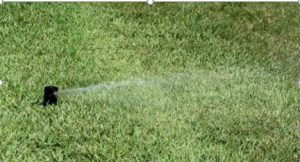Many of you may love to travel by plane, and if you’re anything like me, you may enjoy getting a window seat. I think that there is something wonderful about looking down on the earth, seeing

people moving about their day, fields in different colors among country roads, enjoying the view of other states. Flying into Florida you cannot help but miss the view seeing so much water – streams and rivers, lakes, ponds, and springs, and a state surrounded by water. Read more about the springs of Florida at https://pubs.usgs.gov/fs/1995/0151/report.pdf.
Florida Waters
The water under our feet includes the water at the water table which can be recharged by rain or even excess irrigation water. And even below that is an aquifer. Some may think that an aquifer is an underground lake, perhaps thinking of Jules Vern’s book, “Journey to the Center of the Earth.” But, the aquifer is characterized by underground saturated pores in soil or saturated rocks. Florida has waters we can see from planes or perhaps visit when our feet are back on the ground.
Aquifers and their Health
The major aquifer, which is one of the most productive aquifers in the world, is the Floridan Aquifer. It serves five states including Florida, Alabama, Mississippi, Georgia, and South Carolina. According to the article shared below, it can be protected by impermeable layers (confined) which may force that aquifer water horizontally rather than up and feeding into springs. These springs collectively can have a flow of almost 6.5 million gallons of water per day. Aquifers can be Unconfined aquifers are more at risk for pollution. Read about water quality in the Floridan Aquifer region at https://edis.ifas.ufl.edu/publication/FR440.
So why is this important? The Floridan Aquifer is where we get our drinking water. When too much water is withdrawn from the unconfined saturated stone of the Floridan and possibly other aquifers, it can reduce the flow to the springs. There are ways that we are able to affect the water. Through some of our landscape practices we can affect water in the water table which could flow to surface waters and affecting health of water and reducing the aquifer recharge.
Water Efficiently
The Florida-Friendly LandscapingTM principal Water Efficiently is one way to avoid using excess water. Ultimately, over-watering can affect your bottom line and cost you

more money. Irrigate warm season lawns up to two times a week during the growing season regardless of whether you have Zoysia or St. Augustine. You should water no more than 1/2 inch to 3/4 inch per watering event. Ask your Extension Agent how to calibrate your irrigation system! Irrigating more often than your two times per week, or more than 3/4 inches can lead to water moving past the root zone of your lawn. Don’t forget to check for irrigation water hogs such as geysers, leaks, and clogs which can lead to paying more for water and affecting water resources.
Save Money While Traveling
Ensure that your rain sensor is working especially if you are a “Snowbird” or traveler, so you are not irrigating your lawn during our summer rains! Think of the money and water you will save while you are enjoying, perhaps, cooler, drier weather!
A Few Other Tips
Other tips include avoiding the use of quick release, high nitrogen fertilizers. Use slow or controlled-release fertilizers to keep them from making their way into Florida’s waters like springs. Have insects or diseases identified before using a pesticide. Overwatering can lead to a thatch layer which can increase possible insects and diseases but can also potentially lead to fertilizers and pesticides making their way to possible risks to human health, but can lead to ground water affecting the health of freshwater spring.
To read more about Florida’s Water Resources, visit https://edis.ifas.ufl.edu/publication/FE757 and you can listen to this FFL Minute Radio from Florida-Friendly LandscapingTM Program at https://ffl.ifas.ufl.edu/resources/ffl-minute-radio/2020-archive/december-2020/ffl-principle-2—water-efficiently/.
 0
0
